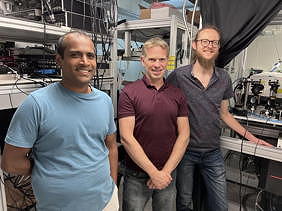Home > Press > ICFO researchers overcome long-standing bottleneck in single photon detection with twisted 2D materials
 |
| From left to right, Roshan Krishna Kumar, Frank Koppens and Krystian Nowakowski in their lab at ICFO.
Credit Image Credit: ICFO |
Abstract:
The ability to detect single photons (the smallest energy packets constituting electromagnetic radiation) in the infrared range has become a pressing need across numerous fields, from medical imaging and astrophysics to emerging quantum technologies. In observational astronomy, for example, the light from distant celestial objects can be extremely faint and require exceptional sensitivity in the mid-infrared. Similarly, in free-space quantum communicationwhere single photons need to travel across vast distancesoperating in the mid-infrared can provide key advantages in signal clarity.
ICFO researchers overcome long-standing bottleneck in single photon detection with twisted 2D materials
Castelldefels, Spain | Posted on August 8th, 2025
The widespread use of single photon detectors in this range is limited by the need for large, costly, and energy-intensive cryogenic systems to keep the temperature below 1 Kelvin. This also hinders the integration of the resulting detectors into modern photonic circuits, the backbone of todays information technologies.
An international team of researchers led by ICFO has now shown one way to overcome this limitation. They have used two-dimensional materials (which are only one-atom thick) to detect long-wavelength single photons (up to the mid-infrared) at relatively high temperatures (around 25 degrees Kelvin). This milestone has caught the attention of the European Space Agency (ESA), which is seeking the use of detectors with these type of properties for space exploration. Today, ICFO researchers, Dr. Krystian Nowakowski, Dr. Hitesh Agarwal, Dr. Julien Barrier, Dr. David Barcons Ruiz, Dr. Geng Li, Riccardo Bertini, Matteo Ceccanti, Dr. Iacopo Torre, Dr. Antoine Reserbat-Plantey, led by Dr. Roshan Krishna Kumar and ICREA Prof. at ICFO Frank Koppens, in collaboration with Prof. Pablo Jarillo-Herrero, researcher and professor at Massachusetts Institute of Technology (MIT) and Distinguished Invited Professor at ICFO, as well as researchers from the University of Manchester, University of Antwerp, among others, have reported their results in Science.
Bistability: a novel mechanism for single photon detection
In our group, we combine different 2D materials. We stack them, twist them, and then observe what happens. And, sometimes, surprises come out, comments ICREA Prof. at ICFO Frank Koppens, senior author of the study and long-time expert in 2D materials.
A slight twist between layers induces an interference pattern known as the moiré pattern, which modifies the properties of the electrons in the material. Several exotic properties, including superconductivity or orbital magnetism, have been observed in moiré lattices. In this work, ICFO together with the international team have added another exotic property to the list, a phenomenon known as bistability. Bistability allows a system to rest in two distinct states under the same external conditions, like a light switch that can remain stable in either the on or off positions.
The team has shown that bistability can serve as a new mechanism for single-photon detectionone of those surprises Koppens describes. We noticed that the material was not behaving as we expected, he recalls. So, we thought, Lets shine some light on it and see what happens. Thats when we suddenly observed an extreme sensitivity to illumination. And the deeper they looked, the clearer it became that the material was responding to individual photons.
As for the results obtained in the experiment, Prof. Jarillo-Herrero highlights, This experiment showcases the great potential of moiré quantum devices not only in terms of fundamental science but also for novel applications in quantum technologies.
Single photons: the straw that broke the camels back
The detector itself is structurally simple. It consists of bilayer graphene (a one-atom-thick layer of carbon atoms, which shows relevant physical properties) sandwiched between layers of hexagonal boron nitride (hBN), another 2D material which acts as a protective shield. However, building the device was tricky, explains Dr. Hitesh Agarwal, first co-author of the study, primarily because achieving the precise alignment between bilayer graphene and hBN had only a 50% success rate. In the end, we managed to solve it through careful design and lessons from earlier experiments, he adds.
So how does this device detect single photons? At an intuitive level, the answer can be grasped with a metaphor. Imagine a huge, empty box on a table, and put a handful of straws (or grains of rice) inside. Nothing happens. But what if you keep putting in more and more straws or rice? Eventually, the weight will become too much, and the table will collapse.
In the laboratory, the researchers engineered a system at the edge of collapse. Instead of straws, we have electrical current that is flowing, says Dr. Krystian Nowakowski, first co-author of the paper. And when we reach the critical point, the device doesnt break but suddenly switches from one stable state to another. When a single photon is absorbed, its like that final strawit triggers the transition, and thats what we detect.
But how exactly does a lone, single photon tip the system? This is something we would all love to know, admits Dr. Nowakowski. We have some hypotheses at the moment, but we need to do more experiments to be able to discern between them. For now, well have to live with the mystery.
What is clear, however, is that this mechanism differs fundamentally from conventional superconducting or semiconductor-based processes. It was precisely this underlying mechanism that allowed the device to detect long wavelength photons (up to the mid-infrared) at relatively high temperatures (around 25 degrees Kelvin). The unique physical mechanism at the heart of our detector architecture allows us to break the fundamental limits that held previous technologies back, shares Dr. Krishna Kumar, who co-supervised the work.
The team is now focused on making the system more compact and pushing the operating temperature even higher, since this is usually the deciding factor that determines whether a certain detector will be used at all. However, many more factors come into play when determining whether a given technology will become practical. Perhaps this new method for detecting single photons won’t prove useful for studying distant galaxies, medically relevant molecules, or quantum information carriers or perhaps it will become a turning point.
####
For more information, please click here
Contacts:
Alina Hirschmann
ICFO-The Institute of Photonic Sciences
Cell: 691513974
Copyright © ICFO-The Institute of Photonic Sciences
If you have a comment, please Contact us.
Issuers of news releases, not 7th Wave, Inc. or Nanotechnology Now, are solely responsible for the accuracy of the content.
News and information
![]()
Sensors innovations for smart lithium-based batteries: advancements, opportunities, and potential challenges August 8th, 2025
![]()
Deciphering local microstrain-induced optimization of asymmetric Fe single atomic sites for efficient oxygen reduction August 8th, 2025
![]()
Lab to industry: InSe wafer-scale breakthrough for future electronics August 8th, 2025
![]()
New imaging approach transforms study of bacterial biofilms August 8th, 2025
Imaging
![]()
Simple algorithm paired with standard imaging tool could predict failure in lithium metal batteries August 8th, 2025
![]()
First real-time observation of two-dimensional melting process: Researchers at Mainz University unveil new insights into magnetic vortex structures August 8th, 2025
2 Dimensional Materials
![]()
First real-time observation of two-dimensional melting process: Researchers at Mainz University unveil new insights into magnetic vortex structures August 8th, 2025
![]()
Lab to industry: InSe wafer-scale breakthrough for future electronics August 8th, 2025
Quantum Physics
![]()
Quantum computers simulate fundamental physics: shedding light on the building blocks of nature June 6th, 2025
![]()
A 1960s idea inspires NBI researchers to study hitherto inaccessible quantum states June 6th, 2025
Videos/Movies
![]()
New X-ray imaging technique to study the transient phases of quantum materials December 29th, 2022
![]()
Solvent study solves solar cell durability puzzle: Rice-led project could make perovskite cells ready for prime time September 23rd, 2022
![]()
Scientists prepare for the worlds smallest race: Nanocar Race II March 18th, 2022
![]()
OCSiAl receives the green light for Luxembourg graphene nanotube facility project to power the next generation of electric vehicles in Europe March 4th, 2022
Possible Futures
![]()
New molecular technology targets tumors and simultaneously silences two undruggable cancer genes August 8th, 2025
![]()
Simple algorithm paired with standard imaging tool could predict failure in lithium metal batteries August 8th, 2025
![]()
First real-time observation of two-dimensional melting process: Researchers at Mainz University unveil new insights into magnetic vortex structures August 8th, 2025
![]()
Lab to industry: InSe wafer-scale breakthrough for future electronics August 8th, 2025
Optical computing/Photonic computing
![]()
Programmable electron-induced color router array May 14th, 2025
![]()
Nanophotonic platform boosts efficiency of nonlinear-optical quantum teleportation April 25th, 2025
![]()
Groundbreaking research unveils unified theory for optical singularities in photonic microstructures December 13th, 2024
Discoveries
![]()
Deciphering local microstrain-induced optimization of asymmetric Fe single atomic sites for efficient oxygen reduction August 8th, 2025
![]()
New molecular technology targets tumors and simultaneously silences two undruggable cancer genes August 8th, 2025
![]()
Simple algorithm paired with standard imaging tool could predict failure in lithium metal batteries August 8th, 2025
![]()
First real-time observation of two-dimensional melting process: Researchers at Mainz University unveil new insights into magnetic vortex structures August 8th, 2025
Announcements
![]()
Sensors innovations for smart lithium-based batteries: advancements, opportunities, and potential challenges August 8th, 2025
![]()
Deciphering local microstrain-induced optimization of asymmetric Fe single atomic sites for efficient oxygen reduction August 8th, 2025
![]()
Japan launches fully domestically produced quantum computer: Expo visitors to experience quantum computing firsthand August 8th, 2025
![]()
New molecular technology targets tumors and simultaneously silences two undruggable cancer genes August 8th, 2025
Interviews/Book Reviews/Essays/Reports/Podcasts/Journals/White papers/Posters
![]()
New molecular technology targets tumors and simultaneously silences two undruggable cancer genes August 8th, 2025
![]()
Simple algorithm paired with standard imaging tool could predict failure in lithium metal batteries August 8th, 2025
![]()
First real-time observation of two-dimensional melting process: Researchers at Mainz University unveil new insights into magnetic vortex structures August 8th, 2025
![]()
Lab to industry: InSe wafer-scale breakthrough for future electronics August 8th, 2025
Aerospace/Space
![]()
Onion-like nanoparticles found in aircraft exhaust May 14th, 2025
![]()
The National Space Society Congratulates SpaceX on Starships 7th Test Flight: Latest Test of the Megarocket Hoped to Demonstrate a Number of New Technologies and Systems January 17th, 2025
Photonics/Optics/Lasers
![]()
Institute for Nanoscience hosts annual proposal planning meeting May 16th, 2025
![]()
Programmable electron-induced color router array May 14th, 2025
Quantum nanoscience
![]()
Programmable electron-induced color router array May 14th, 2025










